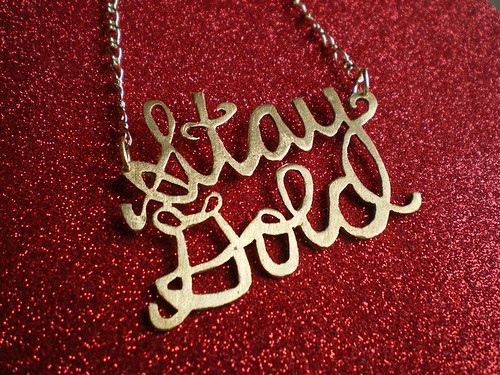12/14/10
Love and Money Artist Profiles: Kalpna Patel
Kalpna Patel is the brains and hands behind craft line Old Weston Handmade Wonders. She has organized craft fairs at Good Catch General Store, is a part of the Toronto Hyperbolic Reef Collective, and is a contributor to Toronto Craft Alert. Check out her fantastic blog, G-Uknit, which is dedicated to the unlikely union of craft and urban hip-hop culture.
Can you talk a bit about the piece you will be showing in Love and Money—the concept, your choice of media, etc?
Protect Ya Neck is a series of 4 hard-carved brass pendants, designed to resemble the iconic gold chains associated with mainstream hip hop culture. On the surface they share the over-the-top, sparkling garishness so common in hip-hop imagery, but the messages and phrases depicted in each piece (borrowed from music or literature) form an autobiographical portrait; a story that starkly contrasts (often humorously, but sometimes with a touch of melancholy) the commercialism, glamour, and grandiosity of the industry and lifestyle that I attempt to mimic aesthetically.
This project explores my own concerns and discomfort with the idea of craft as commerce especially as it relates to the struggle between a manufactured, mainstream aesthetic (or saleable image) and my own craft-based, DIY process. The fashion and accessories of urban, hip hop culture, (though they interest me as a crafter and designer), seem to be necessarily un-DIY (the brands of clothing and shoes are what matter, not how or where they are made and at what social and economic cost), while the common hip hop narrative is completely DIY – rappers often boast of their rise from poverty on the strength of their own skill, talent and craftsmanship, and of careers built on their own terms. It is this notion of the come up – the idea that oppressive challenges don’t always prevent everyone from transcending poverty, and can be overcome with passion, and developed skill – that I appreciate as a self-taught crafter. But the rewards of this success - often represented by material wealth and the accumulation of manufactured, luxury objects with little regard for the social consequences associated with their creation – are a troubling disconnect with the aforementioned DIY mentality and lifestyle.
Protect Ya Neck is informed by this conflict: it is an attempt to appreciate an aesthetic artistically while rejecting its commercial connotations and implications, and without appealing (via the usual allusions to material wealth) to the commercially-driven platform upon which such pieces might be bought and sold. That each piece is carved by hand out of brass, and not machine-cut out of gold reflects a focus on process and skill, rather than on the creation of a polished, commercial product.
How did you originally come to hand carving brass jewelry?
About four years ago, I took a beginner class on metal work with metal and glass artist Tosca Teran, of Nanopod Hybrid Studio in Toronto. The first thing we learned was how to cut shapes out of metal using a simple jeweller’s handsaw. I remember hating it and finding it extremely challenging. At the same time, I also appreciated being able to make something using only very simple instruments, and on not having to rely on complicated tools and equipment or worry about precision. Hand carving metal jewellery was also something I could easily do in the limited space I had available at home, and which didn’t require access to a studio. I enjoy the amount of control I have working with only my hands, and making the metal do what I want it to.
Protect Ya Neck is, at the root of it, a poignant meditation on the DIY ethic in the face of a world overflowing with products yet plagued by ever-increasing economic inequality. What do you think ordinary people could learn from adopting more of a DIY ethic?
I think adopting a DIY ethic fosters a closer, more thoughtful relationship between ourselves and the objects we choose to acquire. When we begin to question how things are made, where they are being made, by whom and out of what materials, that’s when we begin to understand the true value of things. Rather than being concerned with the price of a product, and allowing an expensive price tag to be some indicator of one’s status or individuality, I think it is more important to consider at what price such things are created; paying attention to the social and economic costs and conditions under which things are made should be the deciding factor for many of our consumer choices. While I do not suggest acquiring less, I believe a DIY ethic enables one to acquire thoughtfully.
Love and Money opens at the Ontario Crafts Council this Thursday night from 6-9 pm, and runs from December 16-31, 2010.
Image: Kalpna Patel, Stay Gold necklace
Subscribe to:
Post Comments (Atom)






Brainiacs. I marvel at your abilities to discuss and illuminate.
ReplyDelete